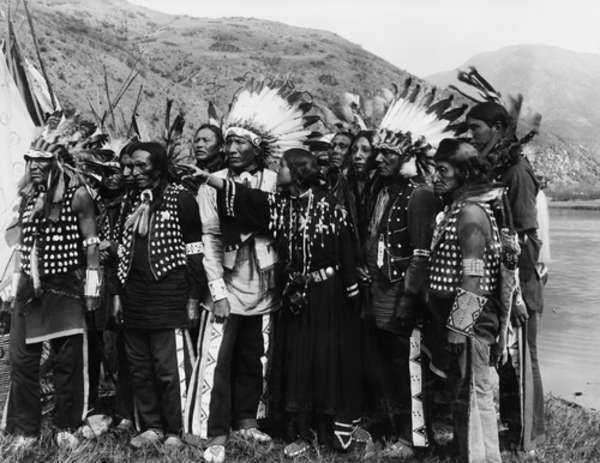Table of Contents
- 1 Background of the Dawes Act
- 2 The Provisions of the Dawes Act
- 3 The Pros of the Dawes Act
- 4 The Cons of the Dawes Act
- 5 Conclusion
- 6 DAWES ACT TEXT
- 7 What is the Dawes Act?
- 8 Why was the Dawes Act Passed?
- 9 What were the Specific Goals of the Dawes Act?
- 10 Important Provisions of the Dawes Act:
- 11 The provisions of the Dawes Severalty Act were as follows:
- 12 Effects of the Dawes Act:
- 13 The Text of the Dawes Act:

The Dawes Act, also known as the General Allotment Act, was a law passed by the United States Congress in 1887 that sought to assimilate Native American tribes into mainstream American culture. The Act divided Native American tribal land into individual plots and encouraged Native Americans to farm the land in order to become more self-sufficient. However, the Dawes Act had a devastating impact on Native American communities, leading to displacement, loss of land, and cultural disruption.
Background of the Dawes Act
In the 1800s, the United States government pursued a policy of westward expansion that often resulted in conflict with Native American tribes. The government often sought to force Native Americans onto reservations, where they could be more easily controlled. However, by the late 1800s, the government began to view assimilation as a more humane and effective means of dealing with Native Americans.
The Dawes Act was introduced by Senator Henry Dawes of Massachusetts, who believed that divvying up tribal lands and distributing them to individuals would make Native Americans more self-sufficient and assimilate them into American culture. Under the Act, the government allowed Native Americans to choose whether they wanted to become United States citizens, but only if they gave up their traditional way of life and adopted American culture.
The Provisions of the Dawes Act
The Dawes Act majorly impacted the way Native Americans were able to live their lives. The Act aimed to divide tribal land into individual plots, with the idea that each Native American would be given a plot of land and taught how to farm it. The allotments were determined based on the number of dependents in a family and were meant to be inalienable for up to 25 years. The idea was that the individual Native Americans would eventually be able to own their own land and become self-sufficient.
The Act gave the United States government the power to take any unallotted land, and any land deemed “surplus” beyond what was necessary for allotment, and sell it to non-Native Americans. The government used this provision to take vast amounts of Native American land, leading to the loss of millions of acres.
The Pros of the Dawes Act
Those who supported the Dawes Act believed that it would be beneficial to Native Americans. They thought that by dividing up tribal land into individual plots, it would bring Native Americans into mainstream American society and encourage them to become self-sufficient farmers. The Act aimed to help Native Americans assimilate into American society and become more like average Americans. Proponents of the Act believed that it would put an end to Native American poverty, which was a significant problem at the time.
The Cons of the Dawes Act
The Dawes Act had disastrous consequences for Native American communities. The Act was based on the false belief that Native Americans wanted to become farmers and that they could become self-sufficient by breaking up their reservations. The Dawes Act ignored the fact that Native American culture, traditions, and ways of life were very different from those of white Americans. Native American tribes were often forcibly relocated onto reservations and had no choice in the matter. Under the Act, Native Americans were stripped of their culture and identity, and many lost their traditional way of life.
The Dawes Act represents a significant episode of forced assimilation and cultural loss. The Act caused immense hardship for Native American communities and led to the loss of millions of acres of land that had been home to these tribes for countless generations.
Conclusion
The Dawes Act represents a dark chapter in United States history, where a government forced another group to assimilate forcefully. The Act was based on the mistaken idea that Native Americans could be assimilated into United States society by breaking up their reservations and making them farmers. In reality, the Act led to the loss of land, displacement, and cultural disruption for Native Americans, and the consequences of the Act are still felt today.
DAWES ACT TEXT
What is the Dawes Act?
Adopted by Congress in 1887, the Dawes Severalty Act was authorized by the Executive branch of the Federal Government to survey Indian tribal land. The Dawes Act emphasized severalty and the delivery of individual rights to Native Americans.
The premise was to divide the land into allotments for individual Native Americans. Sponsored by Massachusetts Senator, Henry L. Dawes, the stated objective of the Dawes Severalty Act was to propel the assimilation of Indians into American society. The Federal government believed that individual land ownership was the starting point for assimilation; if reservations were divided among individual Native Americans, seamless assimilation into American society would follow naturally.
From 1870 to 1900, the Federal policy towards Native Americans shifted from previous policies that revolved around removal, the development of reservations, and war. A shift towards a compassionate and egalitarian policy focused on disbanding reservations through the distribution of land allotments to Native Americans and their tribes.
The Dawes Severalty Act manifested from an American sentiment: if a landowner adopted “white culture”, he would gradually assimilate into the greater population. Following this assimilation, it would then no longer be necessary for the federal government to oversee Indian welfare, including the delivery of meager annuities that seemingly kept the Indian tribes toiling in poverty.
Why was the Dawes Act Passed?
The United States federal government, during the 1850s, attempted to seize control over Native American land. The arrival of European settlers on the eastern coast of the United States (a region that was heavily populated by Native Americans) perpetuated a federal fear involving widespread conflict. This “Indian Problem” stemmed from the inability of the racial societies to coexist with one another in the same community.
In response to the “Indian Problem,” the United States’ Federal Government and William Medill (the commissioner of Indian Affairs) promoted the idea of establishing “reservations. The lands would be exclusively-owned and inhabited by the Native Americans. In essence, this idea was an archaic form of gentrification—the government wanted to uproot the Native Americans from their current positions and force them westward, in turn, offering a new area for the white settlers, while protecting them from conflict with the Natives.
This policy, which concentrated on keeping Native Americans away from European settlers, propagated suffering among the natives, for they were incessantly driven to areas that were less desirable. This widespread suffering promoted distaste and irreverence among the native population; ultimately this uprising led to a violent rebellion.
Following numerous conflicts, the Native Americans eventually gave-in to the dominant American fighting force. Through a series of negotiated treatments, the Native Americans, tired of fighting, relocated to their reservations. The migration left the Natives with roughly 160 million acres of landing ranging from suitable agricultural landscapes to arid deserts.
Although far from ideal, the reservation system allotted each tribe significant liberties and freedoms. The native tribes had protection over their territories, the right to govern themselves (the government was only allowed to intervene through negotiation of treaties), and a claim over their tribal lands. The reservation system thus enabled the Natives to practice their beliefs and hold onto their traditions.
These tribal organizations were in essence, separate societies. They were highly organized (led by a Chief) and individualistic. Because of this uniqueness, and the individual strength of their members, white settlers began to fear Native tribes. The settlers objected to the Native’s lack of “Euroamerican” culture and yearned for a reformation of the tribes.
During the late 1880s, the United States government, Christian reform groups, congressional leaders, and military officials formed a unanimous belief that Native American assimilation into the white culture was paramount. The settlers and the larger “white” culture wanted the natives to disbar their reservations, traditions, and their Indian identities. The settlers wanted to eliminate the “Indian problem”; they wanted to transform their uncivilized and impoverished counterparts into independent Americanized Christian landowners. To promote this assimilation and to develop this cooperating agricultural society, the Dawes Allotment Act was created on February 8. 1887.
What were the Specific Goals of the Dawes Act?
Created by a slew of public officials and religious leaders, the Dawes Severalty Act hoped to achieve the following six accomplishments: Break up native American tribes to rid them of their social dynamic and individualism, progress Native farmers and the agricultural community, reduce the cost of welfare given to natives, secure large chunks of the reserved land, and open the remainder of the reservations to white settlers for profit.
The Dawes Severalty Act ultimately hastened the fate of the Native Americans; the natives were forced to undergo attempts of assimilation and become “Euro-Americanized.” The unity and passion that existed in Native American tribes were tied-into their religious beliefs and the land in which they lived. Their grounds were sacred; the land and the earth were the foundation of their beliefs and traditions. They did not see land as an economic vehicle, only as an embodiment of their existence. This contrast in beliefs and the weighty interpretative difference of the earth ultimately amplified the discord among natives and white settlers.
Although the land was sacred to them, the Natives believed that in order to survive they would have to succumb and surrender to the progressive movement. They were forced to adopt the values of the majority and view land as real estate and not sacred grounds. The Natives were taught how to use their land efficiently to promote profit and sound economic values. While being inducted as citizens of the majority, the Natives were forced to shed their ideologies and exchange their traditions for an industrious sentiment. This transition ultimately separated the Natives from the United States Government’s welfare and supervision programs.
Important Provisions of the Dawes Act:
The provisions of the Dawes Severalty Act were as follows:
• The Dawes Act stated that the head of the family shall receive 160, while single persons or orphans under the age of 18 were granted 80 acres. Lastly, natives under the age of 18 would receive 40 acres each
• The Dawes Act stipulated that the allotments of land would be held in trust by the Government for 25 years
• Eligible natives had four years to choose their allotments. If this time exhausted, the selection would be initiated for them by the Secretary of the Interior
• Citizenship to the United States would be conferred upon only for natives who abandoned their tribes and assimilated into white culture.
Effects of the Dawes Act:
The provisions of the Dawes Severalty Act were not upheld by the United States government—the amount of land allotted to the natives depleted from roughly 150 million acres to 78 million acres in 1900. The 50% depletion was regarded as a surplus and usurped by the government. In turn, the government sold the 75+ million acres to not-natives as well as corporations. The Dawes Act strayed from legislating private native land ownership to bolstering the national economy and satisfying the white population’s demand for land.
By dividing land into privately owned parcels, the United States government hoped to fulfill the assimilation process by destroying the native’s sense of community. After the dissolvent, the government hoped to impose Western values and principles related to economic dependency within these small family units. This goal ultimately failed as the land granted to the natives was neither sufficient nor economically viable to sustain assimilation. Furthermore, when the native’s died, the government would repossess the land, effectively augmented fractionalization.
The majority of allotted land was eventually sold to white settlers or the wealthy at reduced prices–this land was added to the already deemed “surplus”. The Dawes Severalty Act, over the course of 50 years, ironically promoted the loss of 90 million acres of land for Natives—a figured that left almost 100,000 Native Americans landless.
The Text of the Dawes Act:
An Act to Provide for the Allotment of Lands in Severalty to Indians on the Various Reservations, and to Extend the Protection of the Laws of the United States and the Territories over the Indians, and for Other Purposes.
Be it enacted by the Senate and House of Representatives of the United States of America in Congress assembled, That in all cases where any tribe or band of Indians has been, or shall hereafter be, located upon any reservation created for their use, either by treaty stipulation or by virtue of an act of Congress or executive order setting apart the same for their use, the President of the United States be, and he hereby is, authorized, whenever in his opinion any reservation or any part thereof of such Indians is advantageous for agricultural and grazing purposes, to cause said reservation, or any part thereof, to be surveyed, or resurveyed if necessary, and to allow the lands in said reservation in severalty to any Indian located thereon in quantities as follows:
• To each head of a family, one-quarter of a section;
• To every single person over eighteen years of age, one-eighth of a section;
• To each orphan child under eighteen years of age, one-eighth of a section; and
• To each other single person under eighteen years now living, or who may be born prior to the date of the order of the President directing an allotment of the lands embraced in any reservation, one-sixteenth of a section:
Provided, That in case there is no sufficient land in any of said reservations to allot lands to each individual of the classes above named in quantities as above provided, the lands embraced in such reservation or reservations shall be allotted to each individual of each of said classes pro rata in accordance with the provisions of this act: And provided further, That where the treaty or act of Congress setting apart such reservation provides the allotment of lands in severalty in quantities in excess of those herein provided, the President, in making allotments upon such reservation, shall allot the lands to each individual Indian belonging thereon in quantity as specified in such treaty or act: And provided further, That when the lands allotted are only valuable for grazing purposes, an additional allotment of such grazing lands, in quantities as above provided, shall be made to each individual.
SEC. 2. That all allotments set apart under the provisions of this act shall be selected by the Indians, heads of families selecting for their minor children, and the agents shall select for each orphan child, and in such manner as to embrace the improvements of the Indians making the selection, where the improvements of two or more Indians have been made on the same legal subdivision of land, unless they shall otherwise agree, a provisional line may be run dividing said lands between them, and the amount to which each is entitled shall be equalized in the assignment of the remainder of the land to which they are entitled under his act: Provided, That if any one entitled to an allotment shall fail to make a selection within four years after the President shall direct that allotments may be made on a particular reservation, the Secretary of the Interior may direct the agent of such tribe or band, if such there be, and if there be no agent, then a special agent appointed for that purpose, to make a selection for such Indian, which selection shall be allotted as in cases where selections are made by the Indians, and patents shall issue in like manner.
SEC. 3. That the allotments provided for in this act shall be made by special agents appointed by the President for such purpose, and the agents in charge of the respective reservations on which the allotments are directed to be made, under such rules and regulations as the Secretary of the Interior may from time to time prescribe and shall be certified by such agents to the Commissioner of Indian Affairs, in duplicate, one copy to be retained in the Indian Office and the other to be transmitted to the Secretary of the Interior for his action, and to be deposited in the General Land Office.
SEC. 4. That where any Indian not residing upon a reservation, or for whose tribe no reservation has been provided by treaty, the act of Congress, or executive order, shall make settlement upon any surveyed or unsurveyed lands of the United States not otherwise appropriated, he or she shall be entitled, upon application to the local land-office for the district in which the lands are located, to have the same allotted to him or her, and to his or her children, in quantities and manner as provided in this act for Indians residing upon reservations; and when such settlement is made upon unsurveyed lands, the grant to such Indians shall be adjusted upon the survey of the lands so as to conform thereto; and patents shall be issued to them for such lands in the manner and with the restrictions as herein provided. And the fees to which the officers of such local land-office would have been entitled had such lands been entered under the general laws for the disposition of the public lands shall be paid to them, from any amounts of money in the Treasury of the United States not otherwise appropriated, upon a statement of an account in their behalf for such fees by the Commissioner of the General Land Office, and a certification of such account to the Secretary of the Treasury by the Secretary of the Interior.
SEC. 5. That upon the approval of the allotments provided for in this act by the Secretary of the Interior, he shall cause patents to issue therefor in the name of the allottees, which patents shall be of the legal effect, and declare that the United States does and will hold the land thus allotted, for the period of twenty-five years, in trust for the sole use and benefit of the Indian to whom such allotment shall have been made, or, in case of his decease, of his heirs according to the laws of the State or Territory where such land is located and that at the expiration of the said period the United States will convey the same by patent to said Indian, or his heirs as aforesaid, in fee, discharged of said trust and free of all charge or encumbrance whatsoever:
Provided, That the President of the United States may in any case in his discretion extend the period. And if any conveyance shall be made of the lands set apart and allotted as herein provided, or any contract made touching the same, before the expiration of the time above mentioned, such conveyance or contract shall be absolutely null and void: Provided, That the law of descent and partition in force in the State or Territory where such lands are situate shall apply thereto after patents therefor have been executed and delivered, except as herein otherwise provided; and the laws of the State of Kansas regulating the descent and partition of real estate shall, so far as practicable, apply to all lands in the Indian Territory which may be allotted in severalty under the provisions of this act:
And provided further, That at any time after lands have been allotted to all the Indians of any tribe as herein provided, or sooner if in the opinion of the President it shall be for the best interests of said tribe, it shall be lawful for the Secretary of the Interior to negotiate with such Indian tribe for the purchase and release by said tribe, in conformity with the treaty or statute under which such reservation is held, of such portions of its reservation not allotted as such tribe shall, from time to time, consent to sell, on such terms and conditions as shall be considered just and equitable between the United States and said tribe of Indians, which purchase shall not be complete until ratified by Congress, and the form and manner of executing such release prescribed by Congress:
Provided however, That all lands adapted to agriculture, with or without irrigation so sold or released to the United States by any Indian tribe shall be held by the United States for the sole purpose of securing homes to actual settlers and shall be disposed of by the United States to actual and bona fide settlers only tracts not exceeding one hundred and sixty acres to any one person, on such terms as Congress shall prescribe, subject to grants which Congress may make in aid of education:
And provided further, That no patents shall issue therefor except to the person so taking the same as and homestead, or his heirs, and after the expiration of five years occupancy thereof as such homestead; and any conveyance of said lands taken as a homestead, or any contract touching the same, or lieu thereon, created prior to the date of such patent, shall be null and void.
And the sums agreed to be paid by the United States as purchase money for any portion of any such reservation shall be held in the Treasury of the United States for the sole use of the tribe or tribes Indians; to whom such reservations belonged; and the same, with interest thereon at three percent per annum, shall be at all times subject to appropriation by Congress for the education and civilization of such tribe or tribes of Indians or the members thereof. The patents aforesaid shall be recorded in the General Land Office, and afterward delivered, free of charge, to the allottee entitled thereto.
And if any religious society or other organization is now occupying any of the public lands to which this act is applicable, for religious or educational work among the Indians, the Secretary of the Interior is hereby authorized to confirm such occupation to such society or organization, in quantity not exceeding one hundred and sixty acres in any one tract, so long as the same shall be so occupied, on such terms as he shall deem just; but nothing herein contained shall change or alter any claim of such society for religious or educational purposes heretofore granted by law. And hereafter in the employment of Indian police, or any other employees in the public service among any of the Indian tribes or bands affected by this act, and where Indians can perform the duties required, those Indians who have availed themselves of the provisions of this act and become citizens of the United States shall be preferred.
SEC. 6. That upon the completion of said allotments and the patenting of the lands to said allottees, each and every member of the respective bands or tribes of Indians to whom allotments have been made shall have the benefit of and be subject to the laws, both civil and criminal, of the State or Territory in which they may reside; and no Territory shall pass or enforce any law denying any such Indian within its jurisdiction the equal protection of the law. And every Indian born within the territorial limits of the United States to whom allotments shall have been made under the provisions of this act, or under any law or treaty, and every Indian born within the territorial limits of the United States who has voluntarily taken up, within said limits, his residence separate and apart from any tribe of Indians therein, and has adopted the habits of civilized life, is hereby declared to be a citizen of the United States, and is entitled to all the rights, privileges, and immunities of such citizens, whether said Indian has been or not, by birth or otherwise, a member of any tribe of Indians within the territorial limits of the United States without in any manner affecting the right of any such Indian to tribal or other property.
SEC. 7. That in cases where the use of water for irrigation is necessary to render the lands within any Indian reservation available for agricultural purposes, the Secretary of the Interior be, and he is hereby, authorized to prescribe such rules and regulations as he may deem necessary to secure a just and equal distribution thereof among the Indians residing upon any such reservation; and no other appropriation or grant of water by any riparian proprietor shall permitted to the damage of any other riparian proprietor.
SEC. 8. That the provisions of this act shall not extend to the territory occupied by the Cherokees, Creeks, Choctaws, Chickasaws, Seminoles, and Osage, Miamies and Peorias, and Sacs and Foxes, in the Indian Territory, nor to any of the reservations of the Seneca Nation of New York Indians in the State of New York, nor to that strip of territory in the State of Nebraska adjoining the Sioux Nation on the south added by executive order.
SEC. 9. That for the purpose of making the surveys and resurveys mentioned in section two of this act, there be, and hereby is, appropriated, out of any moneys in the Treasury not otherwise appropriated, the sum of one hundred thousand dollars, to be repaid proportionately out of the proceeds of the sales of such land as may be acquired from the Indians under the provisions of this act.
SEC. 10. That nothing in this act contained shall be so construed to affect the right and power of Congress to grant the right of way through any lands granted to an Indian, or a tribe of Indians, for railroads or other highways, or telegraph lines, for the public use, or condemn such lands to public uses, upon making just compensation.
SEC. 11. That nothing in this act shall be so construed as to prevent the removal of the Southern Ute Indians from their present reservation in Southwestern Colorado to a new reservation by and with consent of a majority of the adult male members of said tribe.
Approved, February, 8, 1887.
























